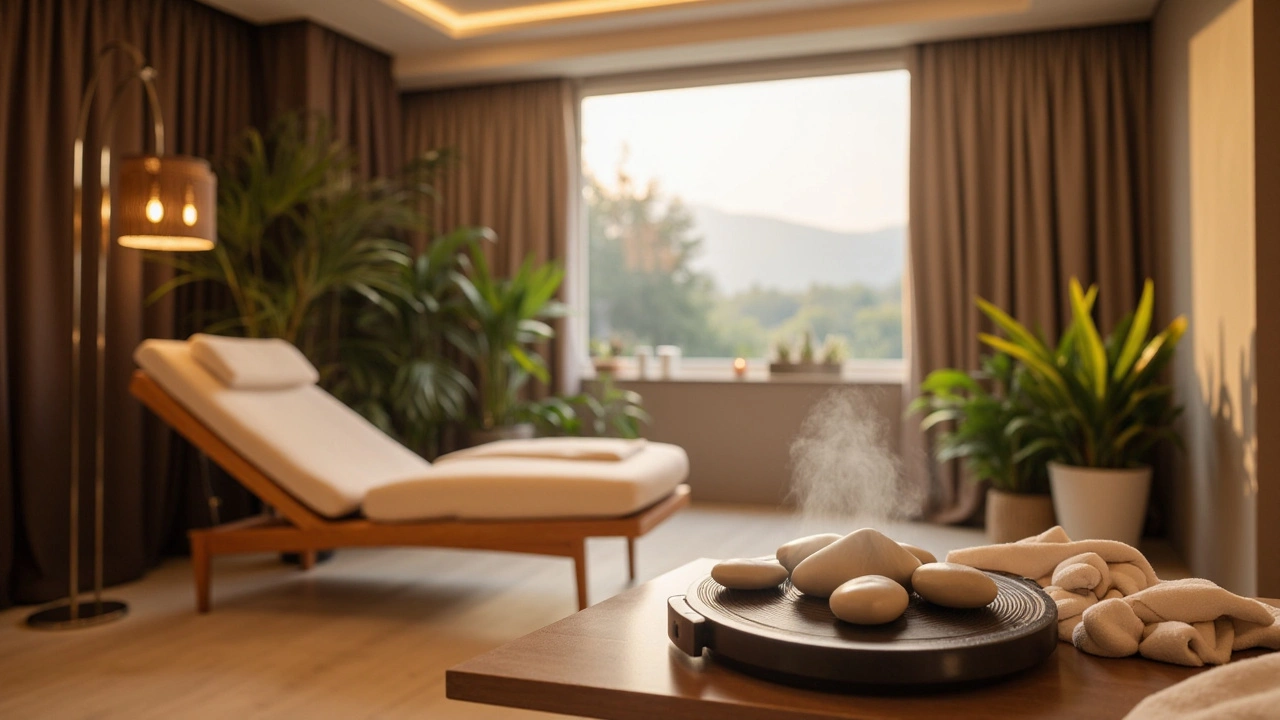10 Surprising Benefits of Deep Tissue Massage You Need to Know

Ever feel like life's got you tied up in knots? We’ve all been there. Sometimes, a deep tissue massage is just what the doctor ordered—literally and figuratively. But, what if I told you it's not just about kneading those sore muscles? There's so much more beneath the surface.
This type of massage is like a deep clean for your body. Have a crick in your neck or tight muscles from hunching over your laptop? Deep tissue massage can work wonders on releasing those pesky tension points. But that's not all; it's also great for helping to detox the body, boosting circulation, and even improving your mood. Who knew getting pampered could be so multifunctional?
If you're new to this, picture it like hitting reset on your body. The massage therapist uses slower, more forceful strokes to target the deeper layers of muscle and connective tissue. Sounds intense? Don't worry, it's way more relaxing than it sounds.
And here's a nugget of trivia to keep in your back pocket: Regular sessions may even enhance flexibility and lower blood pressure over time. So next time you’re thinking of skipping the massage, you might want to reconsider.
- Introduction to Deep Tissue Massage
- Unexpected Health Benefits
- Types of Techniques
- Finding the Right Specialist
- FAQs and Tips
Introduction to Deep Tissue Massage
So, what's all the buzz about deep tissue massage? It's not just another fancy spa offering. It's a powerful technique that focuses on the deeper muscles and fascia, the connective tissue that surrounds muscles. If you've ever had a knot that just wouldn't go away, this technique might be what you need.
The main goal of deep tissue massage is to realign deeper layers of muscles and connective tissue. It's especially helpful for chronic aches and pains such as stiff necks, upper backpain, low back pain, leg muscle tightness, and sore shoulders. According to a study published by the National Institutes of Health, deep tissue massage is beneficial for conditions like fibromyalgia and repetitive strain injuries.
According to Dr. Elliot MacKinnon, a renowned physiotherapist, "Deep tissue massage works by physically breaking down these adhesions to relieve pain and restore normal movement."
Unlike some massages that might leave you gently snoozing, this one can be intense. That's because it uses slow, deliberate strokes and focused pressure to get to the sub-layer of muscles and fascia. It's kind of like finding that one annoying knot in your favorite necklace and working it gently until it's gone.
Benefits Breakdown
Here’s a quick rundown of why deep tissue massage is gaining popularity:
- Muscle Recovery: Especially useful for athletes or those who exercise regularly. It promotes faster healing by increasing blood flow.
- Pain Relief: It's known for its effectiveness in reducing pain, particularly in chronic conditions.
- Enhanced Mood: Can you imagine being grumpy after a relaxing yet effective massage session? Nope, me neither.
It's important to note that while deep tissue massage can be therapeutic, it's not for everyone. Those with open wounds, cuts, or infections should avoid it until they've healed. Also, if you have osteoporosis or are prone to blood clots, it's best to consult a doctor first.
Unexpected Health Benefits
Thinking about a deep tissue massage? Apart from the obvious muscle relaxation, there are some mind-blowing benefits you might not expect. Trust me, it's way more than just feeling good for an hour.
Pain Relief and Management
For those of us struggling with chronic pain, this massage can be a real game-changer. The technique goes beyond the surface to help alleviate pain linked to conditions like arthritis or back pain. Many people report less stiffness and overall discomfort after regular sessions.
Improved Mood and Stress Reduction
Mood swings and stress getting the better of you? Deep tissue massage isn't just physical therapy; it's mental therapy too. The process promotes the release of serotonin and oxytocin—the body’s feel-good hormones. This means you walk away not just with relaxed muscles but a happier mindset too.
Better Sleep Quality
Can’t sleep? You're not alone. Regular massages could lead to deeper sleep. It relaxes the body and calms the mind, helping you say goodbye to tossing and turning all night.
Lowers Blood Pressure
Here's a surprising perk: lowering blood pressure. A study suggested that deep tissue massages might contribute to reducing systolic and diastolic blood pressure. It’s all about letting the stress go and allowing your body to chill out.
Boosts Immune Function
Believe it or not, massages can actually make you healthier. Strengthening your immune system sounds like a stretch? Not really. It increases lymph flow, which helps the immune system fight infections more effectively.
Athletic Performance and Recovery
If you're hitting the gym hard or training for sports events, nothing beats a deep tissue massage for recovery. It enhances blood flow to muscles, which can speed up healing and improve performance over time.
So, next time you book a session, remember it's like giving your body a tune-up. Not just a treat, but a healthy habit that could have you feeling better inside and out.

Types of Techniques
Deep tissue massage is more than just pressing hard on your back; there are various techniques involved that target specific points and cater to different needs. Let’s break down some of the most common techniques you might encounter.
1. Stripping
Stripping is a popular technique used in deep tissue massage. The therapist uses their thumbs or knuckles to glide along the length of the muscle fibers. It’s a slow and deliberate motion aimed at releasing tension and breaking down muscle adhesions. If you’re dealing with tight muscles or knots, this technique helps immensely.
2. Friction
This technique involves moving across the grain of the muscle to break up scar tissue and improve flexibility. Friction is especially useful for injuries or areas with significant tightness. It might feel intense, but remember, it’s all part of the healing process.
3. Trigger Point Release
By pressing on specific points known as trigger points, therapists aim to reduce pain in other parts of the body. Imagine those pesky spots that hurt when you pinch them—trigger point release targets them to help relieve referred pain.
4. Myofascial Release
This technique focuses on the fascia, which is the thin wrapping covering muscles. By gentle stretching and applying sustained pressure, therapists aim to release restrictions within the fascia, increasing circulation and mobility.
5. Active Release Technique (ART)
With ART, the therapist treats muscles, tendons, and nerves by using specific movements combined with manual therapy. It's particularly helpful for athletes or anyone recovering from repetitive strain.
With all these options, you might wonder which technique is best for you. A good therapist will assess your needs and customize the massage technique to maximize benefits. This personalized touch makes a huge difference, ensuring you walk out feeling rejuvenated.
Finding the Right Specialist
Choosing the right specialist for your deep tissue massage can make all the difference. It’s a bit like finding that perfect cup of coffee; once you find the right fit, you’ll wonder how you ever went without it.
Ask for Recommendations
Start by asking around. Reach out to friends, family, or coworkers who might have had a great experience. Personal recommendations can be gold since they're based on real experiences.
Check Credentials
Not all massage therapists are created equal. Look for specialists with proper certification in deep tissue massage. It’s also a good idea to verify their training and any specializations they may have. This ensures they're skilled and know how to cater to your specific needs.
Read Reviews
Hop online and see what other clients are saying. Reviews on platforms like Yelp or Google can give you insight into their experiences. Pay attention to repeated praises or complaints to get a feel for what you might expect.
Consider Their Experience
While everyone has to start somewhere, an experienced therapist will likely have a better touch when it comes to managing and relieving pain or tension. They've probably encountered a wide range of issues and know how to tackle them effectively.
Consultations and Communication
Don't shy away from asking for a preliminary consultation. A good therapist will be open to discussing their methodologies and how they plan to help you. Clear communication can also set the stage for a better session, ensuring you get the most out of your massage.
Location and Convenience
While it’s tempting to pick the first specialist you find, consider their location and convenience. If the place is out of the way, you might end up skipping sessions. Finding a therapist close to home or work can make regular visits more manageable.
In short, your health and relaxation are worth a little homework upfront. Getting the right expertise not only maximizes the benefits but also transforms these sessions into something you’ll genuinely look forward to.

FAQs and Tips
Got questions about deep tissue massage? You’re not alone! Here are some common queries folks have, along with a few handy tips to enhance your experience.
How often should I get a deep tissue massage?
If you're using it for relaxation, once a month is great. But if you’re targeting a specific muscle issue or injury, you might want to ramp it up to every one or two weeks. Always listen to your body and adjust accordingly.
Will it hurt?
It might feel a bit intense, especially if you're not used to it. However, a little discomfort means it's working on those deep layers of muscle. Be sure to communicate with your therapist—you should never feel real pain.
Who should avoid deep tissue massage?
Avoid it if you've had recent surgery, fractures, or if you're dealing with osteoporosis. Pregnant? Best to check with your healthcare provider before booking a session.
Tips for Before Your Massage
Here are a few tips to get the most out of your session:
- Hydrate well the day before and after—it helps in flushing out toxins.
- Don't eat a heavy meal right before; you want to be comfortable, not stuffed.
- Arrive a few minutes early to settle in and de-stress before you start.
Tips for After Your Massage
The benefits can last longer with a few post-massage practices:
- Drink plenty of water to continue flushing out toxins released during the massage.
- Stretch lightly to keep those muscles supple.
- Consider taking a warm bath to enhance relaxation.
Lastly, remember to consider the best timing for your massage—evenings are usually optimal because they allow you to relax afterwards without the hustle and bustle of daily life.



